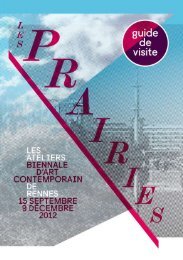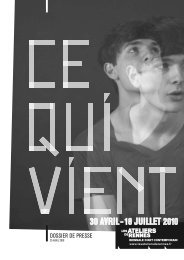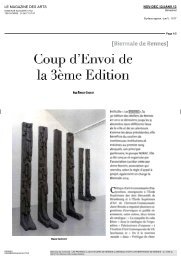Download here the Visitor's guide. - Les Ateliers de Rennes
Download here the Visitor's guide. - Les Ateliers de Rennes
Download here the Visitor's guide. - Les Ateliers de Rennes
Create successful ePaper yourself
Turn your PDF publications into a flip-book with our unique Google optimized e-Paper software.
76<br />
<strong>Les</strong> Prairies's artists<br />
JACKIE WINSOR<br />
Yellow insi<strong>de</strong> out piece, 1984-1985. Collection Frac Bretagne.<br />
Photography : Florian Kleinefenn.<br />
ŽELIMIR ŽILNIK<br />
Zelimir ̌ ŽZilnik's ̌<br />
films are based on a direct<br />
documentary approach to social reality. The<br />
protagonists of his films are often marginal figures<br />
exclu<strong>de</strong>d from <strong>the</strong> social and political system –<br />
street children, <strong>the</strong> unemployed, homeless people,<br />
foreigners, transvestites, people without papers,<br />
gypsies. Zilnik concentrates on different forms of<br />
domination or exclusion from <strong>the</strong> state. Black Film<br />
(1971) shows him in <strong>the</strong> streets of Novia Sad (Serbia)<br />
inviting homeless people to stay with him for two<br />
days. His camera shows first a highly unusual<br />
situation, <strong>the</strong>n an insoluble discussion on <strong>the</strong><br />
question of homeless people. With dark irony, Zilnik ̌<br />
admitted that his position while making <strong>the</strong> film was<br />
ambiguous. He wanted to make a socially committed<br />
film as a means to forgiveness, but he couldn't keep<br />
those men in his home because <strong>the</strong>y stank so much.<br />
He explained later that Black Film is an essay on <strong>the</strong><br />
position of <strong>the</strong> filmmaker. The work is emblematic<br />
of <strong>the</strong> Yugoslavian Black Wave (1963-1972), of which<br />
he was part alongsi<strong>de</strong> Dušan Makavejev,ŽZivojin ̌<br />
Pavlovic ̌ and Aleksandar Petrovic. ̌ Like o<strong>the</strong>r<br />
"New Waves" ̌ in <strong>the</strong> cinema of that period, it had a<br />
profound effect on European film-making.<br />
M. C. tr. J. H.<br />
Born in 1942 in Niš (Serbia), lives and works in<br />
Novi Sad (Serbia).<br />
Jackie Winsor was associated with <strong>the</strong> post-minimalist generation<br />
of artists that inclu<strong>de</strong>d Eva Hesse, Bruce Nauman Richard Serra,<br />
and Richard Grosvenor but she has since <strong>de</strong>veloped a style of her<br />
own that exploits <strong>the</strong> tension between abstract vocabulary and<br />
handling <strong>the</strong> materials. Winsor's interest in form and materials<br />
and <strong>the</strong>ir relationship to space was already apparent in her early<br />
works in <strong>the</strong> 1960s. Her first concern was to arrange things like rope,<br />
string, and steel cables, <strong>the</strong>n to make combinations such as bricks<br />
and ropework, nails and wood. She would work within a geometric<br />
syntax of squares, cubes and grids, letting herself be <strong>gui<strong>de</strong></strong>d by <strong>the</strong><br />
materials. This language enabled her to lay emphasis on <strong>the</strong> way<br />
she used materials, something that was particularly evi<strong>de</strong>nced by<br />
processes of plaiting and knotting (Bound grid, 1971-1972), but also<br />
by visible cut-outs (Yellow insi<strong>de</strong> out piece, 1984-1985). Bound grid<br />
(1971-1972) is a perfect example of her methods. It is a grid of woo<strong>de</strong>n<br />
branches roped toge<strong>the</strong>r with plaited hemp. The process (knotting,<br />
roping, twisting) and <strong>the</strong> thick ropework give such weight to <strong>the</strong> form<br />
that it looks like a craft object or an agricultural implement. Winsor's<br />
manual processes have en<strong>de</strong>d up acquiring a ritual meaning – <strong>the</strong><br />
sense of an artistic ritual invoking a presence in a disembodied<br />
mo<strong>de</strong>rnism from which she has never<strong>the</strong>less taken certain principles<br />
and patterns such as repetition, geometry, and a sense of series.<br />
The forms and <strong>the</strong> vocabulary may be minimalist, but <strong>the</strong> materials<br />
inhabit <strong>the</strong> forms and elaborate an inner syntax. The sculptures<br />
convey <strong>the</strong> sensation of a "dogged existence".<br />
A. B. tr. J.H.<br />
Born in 1941 in Newfoundland (Canada), lives and works in<br />
New-York (United States).<br />
Black film, 1971. Courtesy of <strong>the</strong> l'artist. D. R.






